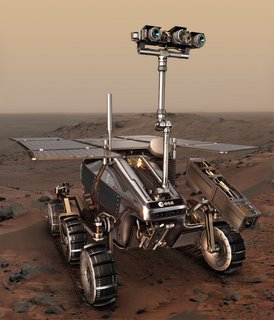
ExoMars Rover from http://www.esa.int/esa-mmg/mmg.pl?keyword=exomars
There are three parts in this mission: a Mars orbiter, a descent module and a Mars rover. After the Mars orbiter has reached Mars and put itself into orbit around the planet, the Mars descent module will deliver the rover to a specific location by using an inflatable braking device or parachute system. The advanced technologies used are robust enough for the Rover to survive the stresses of atmospheric entry and land accurately. The Rover is able to travel for kilometers using conventional solar arrays to generate electricity. Autonomous navigation is made possible with optical sensors and onboard software. This highly intelligent software is designed by SciSys so that the Rover can validate its activity plans with real-time information and repair these plans autonomously should they fail.
It carries the exobiology Pasteur model payload, including panoramic instruments, a subsurface drill, a sample preparation and distribution unit and the analytical lab. The latter includes a microscope, an oxidation sensor and a variety of instruments for characterizing the organic substances and geochemistry in the collected samples. The most important element is the drill which can reach a depth of 2m, monitor and control torque, thrust, penetration, depth and temperature at the drill bit, and conduct mineralogy studies inside the borehole.
ExoMars is the first mission with the mobility to penetrate deep to reach well-preserved organic molecules. Although there is no guarantee of a breakthrough, the many advanced technologies developed for this project presents high hopes and expectations.
References: http://www.esa.int/esaHS/SEM1NVZKQAD_exploration_0.html http://www.primidi.com/2006/05/17.html
Su Shiyan U036793W
5 comments:
It is certainly very advantageous to send robots for such exploration.
At least they don't necessary have to be brought back to earth, since information can be sent back using radiowaves.
This makes space missions easier and less risky than sending humans.
Ong Mei Yee U036855H
One of the disadvantages of relying on solar panels is that the robots have to hibernate during the night costing us time. A new concept,Hyperion, is being developed by NASA & Carnegie Mellon that makes the robot travel synchronously with the sun. That way the robot is functional all the time. Also in adverse climates like on Mercury we can make the robot always stay in the transition period between the day and night when temperature is more favourable. This will be significant advantage to future missons.
Pavan U045965E
http://www.frc.ri.cmu.edu/sunsync/html/Background.htm
The link for Hyperion project.
Pavan U045965E
I think that solar panels are quite good. The technology of it is quite developed. New technology may bring new bring problems, especially those are unexpected. Exploring the Mars is a long way, hibernating at night may not be totally bad, since the machine also need to have a rest after a long day work.
Liu Ming
U048695H
I think the idea of making the robot travel synchronously with the sun to make full use of solar energy is very good. But it may not work for this robot because, it has to drill a deep hole in Mars and extract samples to do analysis. If it were to keep moving, its efficiency may be impeded. But all in all, it is a great idea.
Su Shiyan
U036793W
Post a Comment